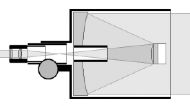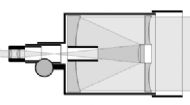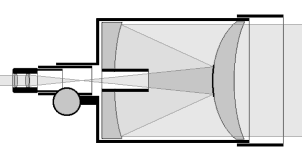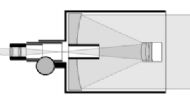Cassegrains and Catadioptrics
Cassegrain Reflectors
To overcome some of the disadvantages of the Newtonian reflector, other configurations have been developed, of which the Cassegrain telescope is probably the most well known version.
The principle is almost the same as with the Newtonian telescope with the difference being that the secondary mirror is not placed at an angle to the main mirror, but parallel to it, reflecting the light back towards the main mirror once again. In the centre of the main mirror is a small hole that lets the focused beam out of the scope.
It would, however, be impractical to use a flat mirror at the secondary, as it would have to be placed too close to the main mirror to be effective and causing a much bigger obstruction than acceptable. Instead, the mirror is slightly convex. This means that the focal length of the combination of mirrors is, in total, much longer than that of the main mirror alone. This means that the beams will come to focus much further away from the secondary mirror, so that it can be placed at a convenient distance (see diagram below).

This stretching of the focal length has the great advantage that it will eliminate some of the disadvantages of fast Newtonians, yet the telescope can be built to be extremely compact. The worlds largest telescopes are of this type, some of which have a prime focal ratio (= focal ratio of main mirror alone) of no more than f/1, yet the total focal length is a much more acceptable f/5, or more.
Cassegrains still have a few of the disadvantages of ‘normal’ reflecting telescopes, such as they are still open at the front and still need to be collimated every now and again, but they generally tend to have longer focal ratios and are therefore more suited for higher magnification without introducing too much field curvature or loss of sharpness.
There are even scopes which allow you to change the configuration from Newtonian to Cassegrain and vice versa, depending on the focal ratio required, and these are very good for both direct observation and astro photography. These hybrids are very rare, however, and are extremely expensive.
Catadioptric Telescopes
In an attempt to further reduce the ill effects of using mirrors instead of lenses, or just to further enhance the quality of the scope or make it more compact without loss of focal length, it is possible to use a combination of a main mirror with lenses. These scopes are usually called Catadioptrics, and there are a great many different versions of them.
Schmidt-Cassegrain Telescopes (SCT)
The most well known version is a Cassegrain telescope that incorporates a large, very complex, ‘lens’ right in front of the telescope opening called a Schmidt Corrector Plate. This plate reduces the field curvature at the focal plane and physically closes the tube so that air turbulence and dust gathering is eliminated.

Schmidt Cassegrains are becoming more and more popular and are the most common form of Cassegrain reflector on the market. They are very compact and because the secondary mirror is usually integrated with the corrector plate, they are much more robust than Newtonian telescopes, i.e., if not abused, they need hardly ever to be collimated. They are, however, quite a bit more expensive than Newtonian telescopes.
Maksutov-Cassegrain Telescopes
A close brother of the Schmidt Cassegrain is the Maksutov Cassegrain scope which also incorporates a corrector plate, but one of a simpler design, but thicker and therefore heavier. The construction of the scope is simpler and they are therefore slightly less expensive than Schmidt Cassegrains. The secondary mirror is usually an aluminised spot on the convex inside of the corrector plate and is smaller than the equivalent Schmidt-Cassegrain, resulting in better contrast and sharper images. Because of the thickness of the Maksutov corrector, large apertures are usually uncommon.

Maksutov Cassegrain lenses are very often used in photography, where they form the majority of high power telephoto lenses. Some manufacturers sell Maksutovs that can be fitted to a camera, or with a focusser and eyepiece, making them very versatile scopes indeed.
Klevsov-Cassegrain Telescopes
A rare version of Cassegrain catadioptric is the Klevsov version. This telescope has a remarkable secondary mirror construction incorporating a lens and a concave mirror that has been aluminised on the back instead. The corrective quality of the secondary mirror construction is quite effective, and scopes of this design are very affordable, yet comparable with good Schmidt or Maksutov Cassegrains.

They are very hard to come by, and again, unlike the Schmidt and Maksutov designs, they are open at the front, re-introducing some of the problems open front telescopes have, such as air turbulence in the tube and dust gathering.